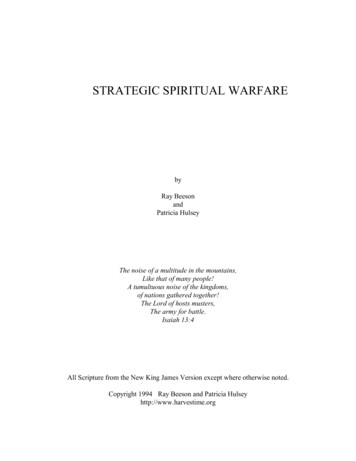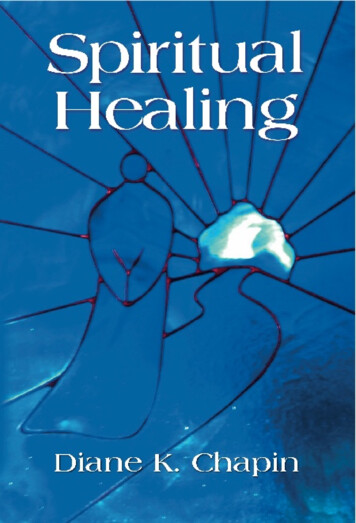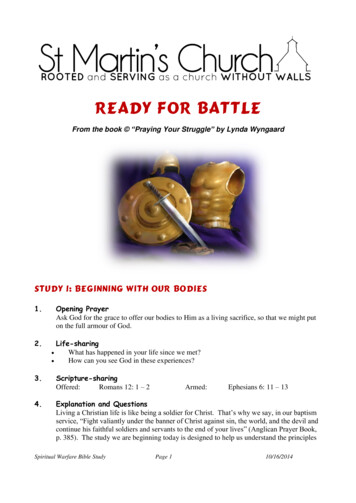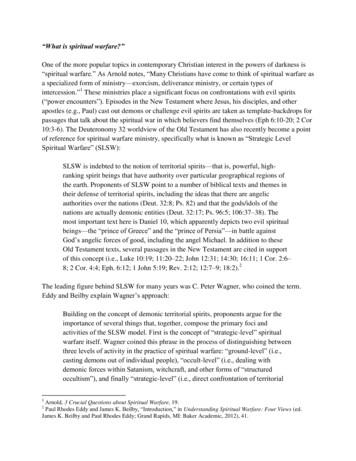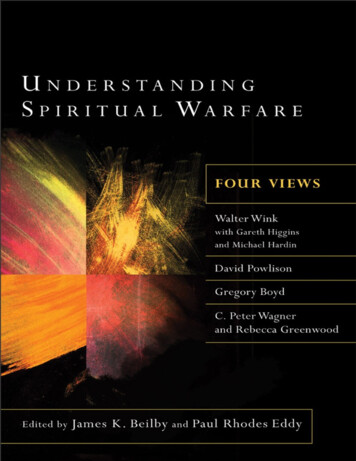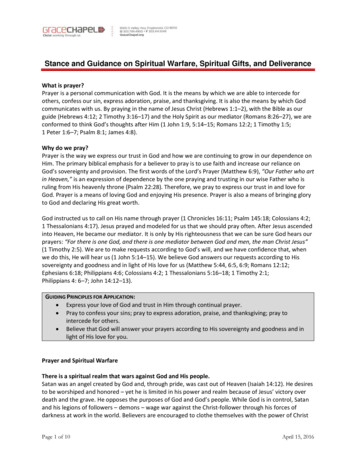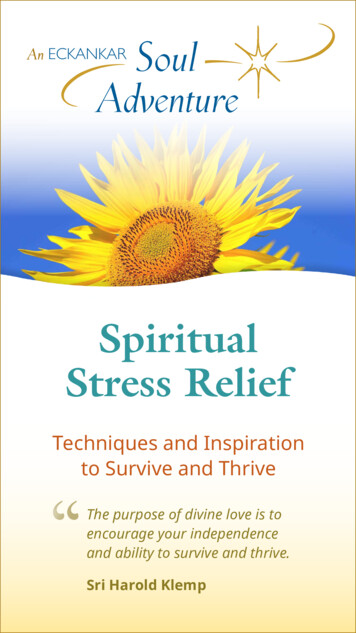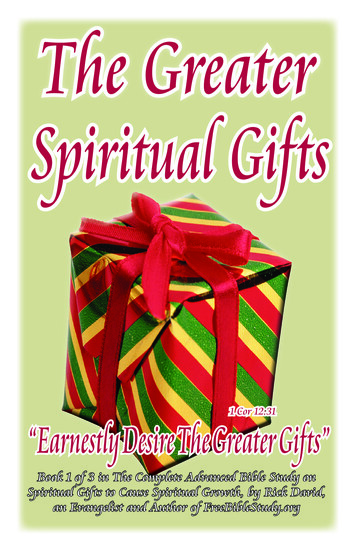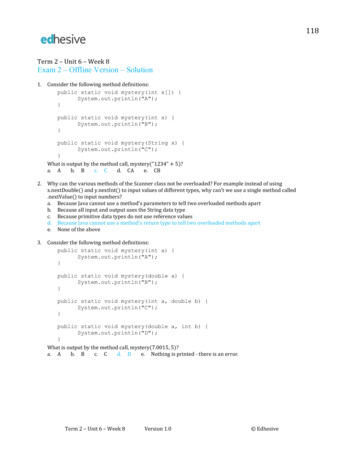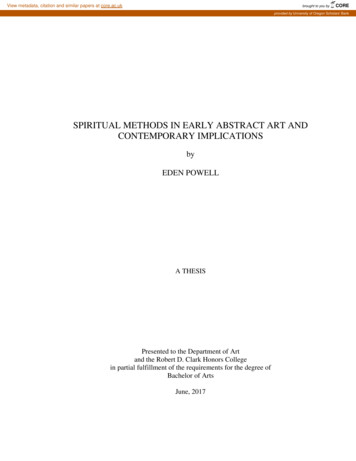
Transcription
View metadata, citation and similar papers at core.ac.ukbrought to you byCOREprovided by University of Oregon Scholars' BankSPIRITUAL METHODS IN EARLY ABSTRACT ART ANDCONTEMPORARY IMPLICATIONSbyEDEN POWELLA THESISPresented to the Department of Artand the Robert D. Clark Honors Collegein partial fulfillment of the requirements for the degree ofBachelor of ArtsJune, 2017
An Abstract of the Thesis ofEden Powell for the degree of Bachelor of Artsin the Department of Art to be taken June 2017Title: Theosophical Methods of Early Abstract Art and Modern ImplicationsApproved:Sylvan LionniThis thesis explores the link between theosophy, a spiritual philosophy derivedfrom Hinduism popular at the turn of the twentieth century, and the birth of abstract art.Theosophy is well documented to have been an interest of many of the most famousearly abstract artists, and the ideas presented by theosophy is clearly represented inthese artists’ work and writing.Theosophy has a special emphasis on unseen forces in the universe, and of theaction of the human soul. These emphases have also been applied by a number oftheosophical writers to the observation of the physical action of the soul, and toexplaining artistic values in terms of theosophy. Contemporary science was alsocommonly applied to theosophy, in terms of the new theories of the time regardingphysics and psychology. These topics were a source of inspiration for the artists beingdiscussed, which are Wassily Kandinsky, Hilma af Klint, Kasimir Malevich, andFrantisek Kupka.I will also be discussing how my work as a painter over the 2016/2017 schoolyear was informed by my research.ii
AcknowledgementsI would like to sincerely thank my Thesis Advisors, Sylvan Lionni, AnyaKivarkis, and Helen Southworth for helping to support and guide me in this process. Iwould also like to thank to all the teachers that I have had in the art department forproviding a challenging and rewarding degree program.Thank you to all friends and family that helped me to edit my thesis document,and to the members of my painting classes this year for critiquing my work, as well asto Laura Vandenburg for artistic guidance. Thank you to Taressa Moretti for letting meuse her easel over winter break.iii
Table of ContentsIntroduction1Introduction to Theosophy4Art and Theosophy17My Own Work36Conclusion56Bibliography60iv
List of Accompanying Paintings by Eden Powell Exhibited at HerThesis Defense1. “Heartsick”, Acrylic on Canvas, 2016.2. “Self Portrait II”, Acrylic on Canvas, 2017.3.“Sunshine”, Acrylic on Canvas, 2016.4. “Death”, Acrylic on Canvas, 2017.5. “Sunset”, Oil on Canvas, 2017.5. “Dreams”, Oil on Canvas, 2017.v
List of FiguresFigure 1. Wassily Kandinsky, Composition VII. 1913, Oil on Canvas, TretyakovGallery, Moscow.25Figure 2: Frantisek Kupka, “Around a Point”, 1920, watercolor on paper, Gertrude SteinGallery, New York.28Figure 3: Hilma af Klint, "Group X, No. 3, Altarpiece," Oil on Canvas, AlbinDahlstrom/Moderna Museet, 1915.32Figure 4: Hilma Af Klint, "Group IV, No.1, Childhood.", Oil on Canvas, AlbinDahlstrom/Moderna Museet, 1907.33Figure 5: Malevich, Kasimir. 0.10 Exhibition Photo. Petrograd, 1915.36Figure 6: Eden Powell, “Heartsick” Acryilic on Canvas, 2016.42Figure 7. Eden Powell, “Self Portrait I”, Acrylic on Canvas, 2016.47Figure 8: Eden Powell, “Self Portrait II”, Acrylic on Canvas, 2017. The black paint wasnot dry enough at the time of the photograph to paint the white square, so I taped apiece of paper to the canvas.49Figure 9: Eden Powell, “Sunshine”, Acrylic on canvas, Eden Powell, 2016.51Figure 10: “Death”, Eden Powell, 2017.54Figure 12: “Dreams”, Oil on Canvas, Eden Powell, 2017.56vi
IntroductionAt the beginning of the 20th century abstraction was “invented” by a few men,Wassily Kandinsky, Kasimir Malevich, Frantisek Kupka and Piet Modrian, to name afew key players, although there seemed to be many that contributed. The through linefor all of these artists is that their paintings were of spiritual subject matter. Theosophywas a metaphysical current that trickled through Europe at the turn of the 20th century,and became attractive to many artists and intellectuals. Theosophy is a philosophy thatsought to imbue modern thought with spirituality, using Indian ideas as well as globalspiritual knowledge and the efforts of clairvoyants. The path of this intellectualmovement intersected with these artists during their careers, shaping their work. As wellas engaging heavily with both accepted and occult science, theosophy also had a lot tosay about the role of art and the imagination in society and the universe.It is my argument that these artists were aided by theosophy in developing theirpioneering abstraction at some level, and that through knowledge of theosophy theirpaintings can be better understood. This is an accepted argument, one that has beenthoroughly written about in art history literature. It is widely known that in the circlesthat early abstractionists moved in, theosophy was a commonly read and discussedtopic. What I will add to the literature is a much more thorough description oftheosophy and its specific links to artistic inspiration, going a little further in depthabout the actual teachings of theosophy than other authors. I will also be writing fromthe perspective of a contemporary artist, trying to directly use and borrow ideas andmodes of thought from early abstractionists to see if they have a place in my art practiceas a painter. Throughout this year I have tried to create a body of work related to my
research, in an attempt to learn what it means for an artist to visually integratetheosophical ideas.The first few lines of Kandinsky’s book on his artistic vision “Concerning theSpiritual in Art” is:“Every work of art is the child of its age and, in many cases, the motherof our emotions. It follows that each period of culture produces an art ofits own which can never be repeated. Efforts to revive the art-principlesof the past will at best produce an art that is still-born.” 1This brings me to my experiment. I am an art student who produces work as part of mydegree. I am at a very early stage in my progress as an artist, and I have not actuallybeen painting seriously for long, but it is a mode of expression that I have found to be acompelling way of discussing content.Abstract painting of the early 20th century quickly began to stand out sharply tome as I started to take art and art history courses for my major, because it is bothmysterious and intuitive at the same time. When I stood in front of Kandinsky’spaintings at the Guggenheim in New York a year ago there was something that mademe feel like I could read his work, and that I was very interested in finding out why theideas he wanted to express had to find their outlet through abstraction.The more I researched the topic the more I came back to theosophy, and the useof abstraction as a way of accessing ideas of spirituality. My experiment, therefore, wasto learn about the teachings of theosophy, focusing on what some of my favorite artistsgot out of it, and produce work informed by what I learn and experience. Since I am nota European artist working during the early 1900’s will my work be “stillborn?” At the1Kandinsky, Wassily. Concerning the Spiritual in Art, Translated by Michael T.H. Sadler, ProjectGutenberg, es.html. Accessed online, no pagenumbers.2
time that these artists were working, physics and other scientific fields were havingsome early breakthroughs, leading to an impetus to unite religion and science as theworld of academia lurched forward. Was this a special moment in history that has nobearing in the world today? Can I be inspired by the same thoughts as the artist I willstudy?What I am doing in my project is to try, as Kandinsky said, “.to awaken [the]capacity for experiencing the spiritual in material and in abstract phenomena.” 2, usingthe scholarship of famous artists, but creating my own work. Theosophical literaturehas lots of highly technical descriptions of occult science and clairvoyant experiments,spanning the microscopic up through the universal. It was frankly a strange experienceto read and think about mystical, outdated, quasi-scientific thought as a modern,educated individual. I also exposed myself to big spiritual and philosophical ideas thatseem to actually be good advice to practicing artists, especially the artistic values laidout in Rudolf Steiner’s speeches on the topic. Clearly, theosophical teachings havesomething to offer the creative intellectual, since they may very well have beenresponsible for an important trajectory in modern art.Researching the spiritual ideas behind the paintings of Kandinsky, Klint, Kupka,and Melevitch also tremendously helped me understand their work and was trulyilluminating in terms of my questions about theosophy and abstract art. The writtenportion of this project will be an investigation into the spiritual thoughts used by theseartists, as well as how their work has impacted me and has helped spawn my paintings.2Donald Kuspitt, “Concerning the Spiritual in Contemporary Art.” The Spiritual in Art: AbstractPainting 1890-1985, Edited by Maurice Tuchman, Abbeville Press Publishers, 1986, p 313.3
As a society it seems that we are at a height of materialism, and perhaps a low ofspirituality. Kandinsky devotes some of his Concerning the Spiritual in Art todiscussing rising materialism enveloping spirituality, little knowing that materialismwould be on the verge of destroying the environment within one hundred years. Ifmaterialism and consumerism and possibly cynicism are at all-time highs, thenaccording to Kandinsky spirituality must be scarce. Perhaps then, instead of exploringthe present environment with my art I should be trying to reach for the knowledge of anearlier time, as perhaps that’s a richer subject matter. I have no problem with turningmy gaze backwards as an artist if many of the issues being dealt with at the turn of thetwentieth century are still unresolved or worse. There was not a mass spiritual shiftguided by an idealistic movement in art, so I feel like continuing to try.Introduction to TheosophyThe official Theosophical Society was founded in 1870 by Helena Blavatsky, aRussian noblewoman who had travelled widely in Asia, and Colonel Olcott, a respectedAmerican Civil War veteran (Northern side). They met at a séance-type event hosted bya mutual friend, and bonded over spiritualism, eventually coming to form a societybased on three official bylaws: “1. To form a nucleus of the universal brotherhood ofhumanity, without distinction of race, creed, sex, caste, or color. 2. To promote thestudy of Aryan and other Eastern literature, religions and sciences and vindicate its4
importance. 3. To investigate unexplained laws of nature and the powers latent inhumanity.” 3This organization established branches throughout Europe and America, butseemed at the time when it was governed by Blavatsky and Olcott to have most of itsengagement in India, where the organization set up thirty-nine branches of operation,and twenty-seven schools for the teaching of Sanskrit in the 1880’s. Blavatsky andOlcott were well-received by Indian scholars, engaging with them widely and starting“The Theosophist” magazine based on their extensive correspondences. Members of theTheosophical Society got along so well with Indian cultural leaders that they weretargeted by Christian missionaries. 4The society got money in its first decades from modest membership fees, andthe sale of “The Theosophist” magazine and Helena Blavatsky’s books. Two pastInternational Presidents of the organization have been women (not counting Blavatsky),with Annie Besant being named president in 1908, before women's suffrage in the UKor America. Blavatsky was effectively the mind behind the formation of the society, andshe produced a huge amount of widely read literature.While it doesn’t seem like there is much specific charity involvement, theSociety is aligned with the intellectual pursuit of humanitarianism. In a letter to theAmerican assembly Blavatsky stated that,“Theosophists are of necessity the friends of all movements in the world,whether intellectual or simply practical, for the amelioration of allmankind. We are the friends of all those who fight drunkenness, againstcruelty towards animals, against injustice to women, against corruptions3American Theosophical Society bylaws (unchanged from original society’s bylaws). The Bylaws of theOfficial Theosophical Society of America,http://www.theosophical.org/files/local groups/NationalBylaws1999.pdf4Kirby Van Mater, Introduction, H.P. Blavatsky to the American Conventions 1888-1891, pp. 3.5
in society or government.We are the friends of those who exercisepractical charity, who seek to lift a little of the tremendous weight ofmisery that is crushing down on the poor.” 5So what is theosophy? To answer this question I will be paraphrasing fromHelena Blavatsky’s The Key To Theosophy, as this book is intended to answer thatquestion for curious researchers. The aim of the movement is to unite all religious areasof study under a universal brotherhood, with the motto of the society being “There is noreligion higher than truth.”, and to unite these religions under core values. 6 This goalcomes from the idea that all separate religions branch off a “Wisdom-Religion” that wasmore universal in ancient times and was advanced by various scholars throughout earlysocieties. 7 Blavatsky also endorses the idea that as well as there being a root religion,there is a common source of physical life, explained by Darwinism, and that based onthis there should be a concept of universal brotherhood. The materialism of secularscience does not allow this idea to flourish because it is more focused on describingnature than discussing the implications of this for the community of humanity. 8Theosophists can belong to any religion, and engage in personal study thatabides by the ethics of the society. Those who are lay-members benefit from the societyin that they receive community and knowledge from the society. 9 That said, Theosophyis an esoteric and exoteric practice, meaning that there is an outer and inner circle ofknowledge. The inner circle concerns itself with the occult sciences.Occult Science is defined in Blavatsky’s handy Theosophical Glossary as:5Ibid. pp. 7.H.P. Blavatsky, Edited by Clara M. Codd. The Key to Theosophy, 1953, pp. 2-3.7Ibid. pp. 4-7.8Ibid. p. 43.9Ibid. pp. 19-21.66
“The science of the secrets of nature- physical and psychic, mental andspiritual; called Hermetic and Esoteric Sciences. In the West, theKabbalah may be named; in the East, mysticism, magic, and yogaphilosophy These sciences are, and have been for ages, hidden fromthe vulgar for the very good reason that they would never be appreciatedby the selfish educated class , nor understood by the uneducated; whilstthe former might misuse them for their own profit, and thus turn thedivine science into black magic.” 10This refers to the “adepts” of theosophy, who practice clairvoyance, but do so for thebetterment of man, and under the rigors of science. The study of occult science doesoften seem to rely on those gifted with psychic powers, and seeks to explain thosephenomena and use people with these gifts as tools for study. For instance, in AnnieBesant’s book Thought Forms, occult researchers describe and draw images of theshapes and colors that they see emerge around someone when they have thoughts.That outlines the general framework of what I mean when I use the term“Theosophy”, and gives some context to what it would have meant for someone to beinterested in the theosophical movement in the early twentieth century. What draws meto this topic, is that this expansive network of researchers were trying to create a culturewhere the deep mysteries of what it means to be a human could be discussed. Theliterature surrounding theosophy deals with spirituality as a science, and takes thingssuch as auras and astral projections as factual and observable experiences that need tobe researched.In the modern world there is so much that cannot be explained by science, andeven if we think we know something it might not be true. In Concerning the Spiritual inArt, Kandinsky writes about how society can be thought of as a tiered triangle, withthose at the lower levels being individuals who do not have a spiritual life and live10H.P. Blavatsky, and G. R. S Mead, The Theosophical Glossary, Theosophy Press, 1990, p. 237.7
through the insights and discoveries of others. Kandinsky’s triangle moves upwards,with those who can explain and justify their beliefs passing down this knowledge to thelower levels, so that thought does generally move forwards, and intellectuals passestablished ideas to the masses. Because of this idea of societal progress, those at theupper levels of the triangle feel uncertainty in everything, because the ideas that wereonce accepted are now archaic, and therefore they have the concern that no questionwill ever be solved. At the top of the triangle are those who embrace the uncertainty ofeverything:“There work is going on which boldly attacks those pillars which menhave set up. There we find other professional men of learning who testmatter again and again, who tremble before no problem, and who finallycast doubt on that very matter which was yesterday the foundation ofeverything, so that the whole universe is shaken.” 11These are people who don’t take anything in the world for granted, or acceptany explanation as final. When this quote was brought up in my painting class last yearsomeone disagreed, saying that there are constant, knowable things, and he cited deathas one of those things. The instructor (Sylvan Lionni) responded by mentioningresearch at its very beginning, in which scientists are studying telomeres, the parts ofour DNA that dictate aging, and trying to see if there is any way to change them sohumans do not age. Today in society nobody dies of smallpox, tomorrow perhaps noone will die of old age.Theosophy simply does not take the human soul for granted. In an age whereorganized religion seemed to be inching towards materialism, and science was doing11Kandinsky, Wassily. Concerning the Spiritual in Art, Translated by Michael T.H. Sadler, ProjectGutenberg, es.html. Accessed online, so I do nothave page numbers.8
away with the soul through new discoveries about the body, theosophy looked to minescience, and the world religions, for explanations for the experience of having a soul.This is where the occult comes in. A main line of study for the authors of thismovement was trying to explain human consciousness in physical terms. Theexperience of having awareness, thoughts, and a personality are things that bothpsychology and philosophy are still wrestling with. The issue is one that stems from theincongruence created by the sensation that people have when they realize that they aremade of physical matter, but have a sense of self, which is sometimes called the MindBody Problem.What is a thought? What is a memory? From my own perspective, it does seemlike there is a tiny version of me in my head controlling all my actions, but what wouldshe be made out of? Or perhaps I have a glowing soul that animates me and could bepulled out of my body through some supernatural process?Functionalism was a way of thinking about this problem proposed in 1896 byJohn Dewy, “Functionalism says that mental states are constituted by their causalrelations to one another and to sensory inputs and behavioral outputs.” 12 This theorymakes mental processing somewhat analogous to a computer processor, where there is asensory input and all thoughts, even complex ones, are a direct reaction. This theoryworks well with physicalism, the viewpoint that everything in the body is physical, andthat there is no separate mental sphere at all, just cells and impulses.Theories like this do not really light the spiritual imagination on fire,especially if a person is also interested in visual occult phenomenon. If a clairvoyant12Ned Block, "What is functionalism?" a revised version of the entry on functionalism in TheEncyclopedia of Philosophy Supplement, Macmillan, ock/papers/functionalism.html9
had literally seen a human soul separate from a body, then discussing psychology interms of moving parts would be very unsatisfying. The Theosophical Society took issuewith materialist science that only studied what could be observed with the normalsenses, and did not engage with the human soul, or with the possibility for higher planesof existence.Luckily for the occult scientists, physics was dipping into the world of theunseen heavily. Incoming discoveries pointed to forces that were not observable, andinstead were made of vibrations, or energy flowing through etheric matter.“X-rays, discovered by Roentgen in 1895, made solid mattertransparent and raised fundamental questions about the adequacy of theeye as a sensing instrument. Further challenges to the solidity of matterfollowed with Becquerel’s discovery of radioactivity in 1896, J. J.Thomson’s identification of the electron in 1897, and, especially, thesubsequent work of the Curies and Ernest Rutherford on radioactivity.Popular science writers regularly suggested that all matter might beradioactive, offering the image of objects endlessly emitting particlesinto the surrounding ether.” 13This emerging body of knowledge was incendiary for those investigating theinvisible forces of the soul, because something invisible like radioactivity or X-rayscould be more easily classified in the same school of thought as auras, or astralprojections. If there were forces moving through space that were real, but nobody couldsee them, then the excuse that nobody could “see” a soul and therefore souls were notreal, did not hold up as well anymore. Clairvoyants became the Geiger counters ofoccult science. The goal of the extensive literature produced by the TheosophicalSociety was not to sell an intriguing account of unexplainable magic occurrences, or to13Linda Dalrymple Henderson, “The Forgotten Meta-Realities of Modernism: Die Uebersinnliche Weltand the International Cultures of Science and Occultism.” Glass Bead, 2016, ties-of-modernism/?lang enview.10
tell stories of ghosts, or teach mysticism or witchcraft. The goal was to incorporate theunseen realm into the scientific conversation. Rudolf Steiner writes in his 1909 bookOutline of Occult Science:“Occult science desires to free the natural-scientific method and itsprinciple of research from their special application that limits them, intheir own sphere, to the relationship and process of sensory facts, but, atthe same time, it wants to retain their way of thinking and othercharacteristics. It desires to speak about the non-sensory in the same waynatural science speaks about the sensory.” 14At the beginning of the 20th century intellectuals wanted to know aboutscience, and at that time invisible forces were exciting discoveries. These new ways ofthinking about particles and energy, paired with a blossoming of occult writings anddiscoveries, made it so that images of vibrations, waves, and the physical manifestationsof the soul were on the minds of many.“.it can be demonstrated that there was an international culture ofoccultism as well as of science, which readily transcended nationalborders. Like the internet today, these ideas travelled rapidly onnetworks formed by monthly occult journals reporting on developmentsfrom all over Europe and America and even further destinations (India,particularly, for the Theosophists).” 15Researchers wanted to get physical proof of the soul, in an illustration, concisedescription, or even a photograph. In 1985 Baron Carl von Reichenbach publishedResearches on Magnetism, Electricity, Heat and Light in their Relations to Vital Forces,a book about his experiments with the “odic force”, a sort of electromagnetic field thathe had observed coming off of magnets, crystals, and people. He does research thatindicates that those who are in poor health, or those who are extremely nervous are able14Rudolf Steiner, An Outline of Occult Science. Translated by Maud and Henry B Monges.Anthroposophic Press, Inc., 1972, p.6.15Linda Dalrymple Henderson, “The Forgotten Meta-Realities of Modernism: Die Uebersinnliche Weltand the International Cultures of Science and Occultism.” Glass Bead, 2016, ties-of-modernism/?lang enview.11
to see light coming off of magnets, and feel physical sensations on their skin when amagnet is passed over them. He showed a series of young women strong magnets whilethey sat in a dark room. The women would then give descriptions of light coming off ofthe ends of the magnets, in a vapor-like flame. He does very careful experiments withthe objects he studies, observing whether they have heat, or can be photographed, or canonly be seen in the dark, trying to find universal properties of this force. 16Dr. Hippolyte Baraduc became known in the early 1900s for usingphotography to capture “The Fluidic Invisible”, a separate body made of “OdicFluid”, 17 that exists as a binding intermediary between the physical body and the soul.He was very inspired by Baron Carl von Reichenbach, and it does seem like the nextstep of Reichenbach’s work to try to photograph the forces he wrote about. Just as withReichenbach, careful measurements were taken, and results were meant to be replicable.Can vital force work in a vacuum? Can it be felt through a block of ice? Could hismeasurements be affected by confounding factors?Annie Besant, became president of the Theosophical Society in 1907, duringa career that featured leading movements for women’s rights, freemasonry, andsocialism. Thought Forms, a book she published with a close collaborator C.W.Leadbeater in 1901, deals with the idea that the thoughts we have can be seen byclairvoyants as physical objects. In the introduction she makes a poignant statementabout theosophy and science:16Baron Carl von Reichenbach, Researches on Magnetism, Electricity, Heat and Light in their Relationsto Vital Forces, Taylor, Walton and Maberly, 1850.17Hippolyte Baraduc, The Human Soul : Its Movements, Its Lights, and the Iconography of the FluidicInvisible, Librairie Internationale de la Pensée Nouvelle, 1913, p. 20.12
“The fact is that science has pressed its researches so far, has used suchrare ingenuity in its questionings of nature, has shown such tirelesspatience in its investigations, that it is receiving the reward of those whoseek, and forces and beings of the next higher plane of nature arebeginning to show themselves on the outer edge of the physical field."Nature makes no leaps," and as the physicist nears the confines of hiskingdom he finds himself bewildered by touches and gleams fromanother realm which interpenetrates his own. He finds himself compelledto speculate on invisible presences, if only to find a rational explanationfor undoubted physical phenomena, and insensibly he slips over theboundary, and is, although he does not yet realise it, contacting the astralplane.” 18This quote so perfectly sums up how theosophy fits into the scientificknowledge of the time. Theosophy was not taking an anti-science perspective, it wasactually pushing for scientific development in the areas of the unseen. Theosophyadvocates for the research of things that are unobservable by laymen, and pushesresearch to incorporate recorded clairvoyant experiences. “Nature makes no leaps”, isthe key phrase here, meaning that Besant thinks that as humans gain more knowledgeabout their world they will come to understand their spiritual lives as well, and thatthere is no chasm between science and religion for humanity to leap across, and insteadthere is only truths to be revealed about the nature of the universe. As science edges intodescribing more complex forces it will also begin describing the nature of the soul. Thedanger that Blavatsky speaks of comes from this research remaining separate fromspirituality, and therefore missing the potential yields for spiritual knowledge, and onlyfocusing on the material, and on earthly existence. The end result for gaining trueunderstanding about the universe is that humanity becomes less focused on the value ofthe material and more on the value of the spiritual life, which could yield a more moral,united humanity.18Annie Besant, and C.W Leadbeater. Thought-Forms. The Theosophical Publishing House, 1901,Project Gutenberg, www.gutenberg.org/files/16269/16269-h/16269-h.htm, Online source without pagenumbers.13
Karma is dealt with in occult science according to Rudolf Steiner, in that when aperson harms another person it mars their own soul and they have to relive that harmupon death. 19 Perhaps if everyone believed in this conception of the soul the physicalworld would be more kind. Also if every person also exists on an astral plane as well asthe physical one there are not real divisions among humanity, and the idea of a“Universal brotherhood” seems logical and realistic. And who cares about wealth if thematerial world is just a mask for a non-physical universe? This is why Besant writes sooptimistically about science, because if the existence of the soul can be proven tohumanity, then the goals of theosophy could be achieved.What I’ll mention now is that I have studied this topic at what I can only call asurface level. In my research I focused on what I thought would be useful for myunderstanding of abstract art, I did not read The Secret Doctrine, or very much ofBlavatsky’s work at all, because it is very extensive and I did not th
5. "Sunset", Oil on Canvas, 2017. 5. "Dreams", Oil on Canvas, 2017. vi . List of Figures . Figure 1. Wassily Kandinsky, Composition VII. 1913, Oil on Canvas, Tretyakov . paintings at the Guggenheim in New York a year ago there was something that made . the sale of "The Theosophist" magazine and Helena Blavatsky's books. Two past
